+ Open data
Open data
- Basic information
Basic information
| Entry | Database: PDB / ID: 1lwr | ||||||
|---|---|---|---|---|---|---|---|
| Title | Solution structure of the NCAM fibronectin type III module 2 | ||||||
 Components Components | Neural Cell Adhesion Molecule 1, 140 kDa isoform | ||||||
 Keywords Keywords |  CELL ADHESION / All beta / Fibronectin type III module CELL ADHESION / All beta / Fibronectin type III module | ||||||
| Function / homology |  Function and homology information Function and homology informationNCAM1 interactions /  regulation of exocyst assembly / regulation of semaphorin-plexin signaling pathway / calcium-independent cell-cell adhesion via plasma membrane cell-adhesion molecules / cellular response to molecule of bacterial origin / regulation of exocyst assembly / regulation of semaphorin-plexin signaling pathway / calcium-independent cell-cell adhesion via plasma membrane cell-adhesion molecules / cellular response to molecule of bacterial origin /  peripheral nervous system axon regeneration / peripheral nervous system axon regeneration /  LRR domain binding / homotypic cell-cell adhesion / NCAM signaling for neurite out-growth / Signal transduction by L1 ...NCAM1 interactions / LRR domain binding / homotypic cell-cell adhesion / NCAM signaling for neurite out-growth / Signal transduction by L1 ...NCAM1 interactions /  regulation of exocyst assembly / regulation of semaphorin-plexin signaling pathway / calcium-independent cell-cell adhesion via plasma membrane cell-adhesion molecules / cellular response to molecule of bacterial origin / regulation of exocyst assembly / regulation of semaphorin-plexin signaling pathway / calcium-independent cell-cell adhesion via plasma membrane cell-adhesion molecules / cellular response to molecule of bacterial origin /  peripheral nervous system axon regeneration / peripheral nervous system axon regeneration /  LRR domain binding / homotypic cell-cell adhesion / NCAM signaling for neurite out-growth / Signal transduction by L1 / cellular response to inorganic substance / thalamus development / LRR domain binding / homotypic cell-cell adhesion / NCAM signaling for neurite out-growth / Signal transduction by L1 / cellular response to inorganic substance / thalamus development /  fibroblast growth factor receptor binding / commissural neuron axon guidance / axonal fasciculation / negative regulation of programmed cell death / RAF/MAP kinase cascade / response to inorganic substance / neuron development / fibroblast growth factor receptor binding / commissural neuron axon guidance / axonal fasciculation / negative regulation of programmed cell death / RAF/MAP kinase cascade / response to inorganic substance / neuron development /  epithelial to mesenchymal transition / multicellular organismal response to stress / epithelial to mesenchymal transition / multicellular organismal response to stress /  phosphatase binding / animal organ regeneration / positive regulation of calcium-mediated signaling / positive regulation of cardiac muscle cell proliferation / phosphatase binding / animal organ regeneration / positive regulation of calcium-mediated signaling / positive regulation of cardiac muscle cell proliferation /  cytoskeletal protein binding / response to activity / response to cocaine / calcium-mediated signaling / response to lead ion / modulation of chemical synaptic transmission / Schaffer collateral - CA1 synapse / neuron projection development / cell-cell junction / cytoskeletal protein binding / response to activity / response to cocaine / calcium-mediated signaling / response to lead ion / modulation of chemical synaptic transmission / Schaffer collateral - CA1 synapse / neuron projection development / cell-cell junction /  presynaptic membrane / presynaptic membrane /  heparin binding / heparin binding /  growth cone / growth cone /  postsynaptic membrane / learning or memory / cell surface receptor signaling pathway / postsynaptic membrane / learning or memory / cell surface receptor signaling pathway /  cell adhesion / response to xenobiotic stimulus / cell adhesion / response to xenobiotic stimulus /  axon / external side of plasma membrane / neuronal cell body / glutamatergic synapse / axon / external side of plasma membrane / neuronal cell body / glutamatergic synapse /  cell surface / cell surface /  plasma membrane plasma membraneSimilarity search - Function | ||||||
| Biological species |   Rattus norvegicus (Norway rat) Rattus norvegicus (Norway rat) | ||||||
| Method |  SOLUTION NMR / distance geometry; simulated annealing SOLUTION NMR / distance geometry; simulated annealing | ||||||
 Authors Authors | Kiselyov, V.V. / Skladchikova, G. / Hinsby, A.M. / Jensen, P.H. / Kulahin, N. / Pedersen, N. / Tsetlin, V. / Poulsen, F.M. / Berezin, V. / Bock, E. | ||||||
 Citation Citation |  Journal: Structure / Year: 2003 Journal: Structure / Year: 2003Title: Structural basis for a direct interaction between FGFR1 and NCAM and evidence for a regulatory role of ATP Authors: Kiselyov, V.V. / Skladchikova, G. / Hinsby, A.M. / Jensen, P.H. / Kulahin, N. / Soroka, V. / Pedersen, N. / Tsetlin, V. / Poulsen, F.M. / Berezin, V. / Bock, E. | ||||||
| History |
|
- Structure visualization
Structure visualization
| Structure viewer | Molecule:  Molmil Molmil Jmol/JSmol Jmol/JSmol |
|---|
- Downloads & links
Downloads & links
- Download
Download
| PDBx/mmCIF format |  1lwr.cif.gz 1lwr.cif.gz | 862.3 KB | Display |  PDBx/mmCIF format PDBx/mmCIF format |
|---|---|---|---|---|
| PDB format |  pdb1lwr.ent.gz pdb1lwr.ent.gz | 727.9 KB | Display |  PDB format PDB format |
| PDBx/mmJSON format |  1lwr.json.gz 1lwr.json.gz | Tree view |  PDBx/mmJSON format PDBx/mmJSON format | |
| Others |  Other downloads Other downloads |
-Validation report
| Arichive directory |  https://data.pdbj.org/pub/pdb/validation_reports/lw/1lwr https://data.pdbj.org/pub/pdb/validation_reports/lw/1lwr ftp://data.pdbj.org/pub/pdb/validation_reports/lw/1lwr ftp://data.pdbj.org/pub/pdb/validation_reports/lw/1lwr | HTTPS FTP |
|---|
-Related structure data
| Similar structure data |
|---|
- Links
Links
- Assembly
Assembly
| Deposited unit | 
| |||||||||
|---|---|---|---|---|---|---|---|---|---|---|
| 1 |
| |||||||||
| NMR ensembles |
|
- Components
Components
| #1: Protein |  / NCAM / NCAM polypeptide / N-CAM 140 / NCAM-140 / NCAM / NCAM polypeptide / N-CAM 140 / NCAM-140Mass: 10657.956 Da / Num. of mol.: 1 Source method: isolated from a genetically manipulated source Source: (gene. exp.)   Rattus norvegicus (Norway rat) / Gene: Ncam1 / Plasmid: pPICZa / Production host: Rattus norvegicus (Norway rat) / Gene: Ncam1 / Plasmid: pPICZa / Production host:   Pichia pastoris (fungus) / Strain (production host): KM71 / References: UniProt: P13596 Pichia pastoris (fungus) / Strain (production host): KM71 / References: UniProt: P13596 |
|---|
-Experimental details
-Experiment
| Experiment | Method:  SOLUTION NMR SOLUTION NMR | ||||||||||||||||||||||||||||||||
|---|---|---|---|---|---|---|---|---|---|---|---|---|---|---|---|---|---|---|---|---|---|---|---|---|---|---|---|---|---|---|---|---|---|
| NMR experiment |
| ||||||||||||||||||||||||||||||||
| NMR details | Text: This structure was determined using standard 2D homonuclear techniques and triple-resonance NMR spectroscopy |
- Sample preparation
Sample preparation
| Details |
| ||||||||||||
|---|---|---|---|---|---|---|---|---|---|---|---|---|---|
| Sample conditions | Ionic strength: 40 mM / pH: 7.27 / Pressure: ambient / Temperature: 298 K | ||||||||||||
Crystal grow | *PLUS Method: other / Details: NMR |
-NMR measurement
| NMR spectrometer | Type: Varian UNITY / Manufacturer: Varian / Model : UNITY / Field strength: 750 MHz : UNITY / Field strength: 750 MHz |
|---|
- Processing
Processing
| NMR software |
| ||||||||||||||||
|---|---|---|---|---|---|---|---|---|---|---|---|---|---|---|---|---|---|
| Refinement | Method: distance geometry; simulated annealing / Software ordinal: 1 | ||||||||||||||||
| NMR representative | Selection criteria: lowest energy | ||||||||||||||||
| NMR ensemble | Conformer selection criteria: Z-scores less than 2.4 / Conformers calculated total number: 78 / Conformers submitted total number: 30 |
 Movie
Movie Controller
Controller



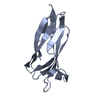
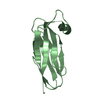
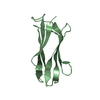

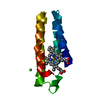
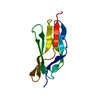
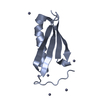
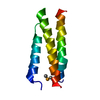


 PDBj
PDBj







